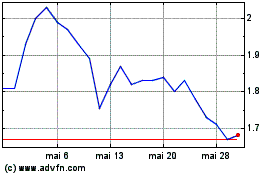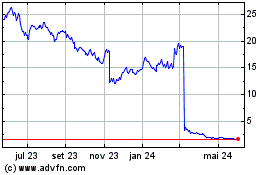- Interim analysis, including eight
participants assessed at Week 24, demonstrated improvements in
pancreatic function and glycemic control, as measured by C-peptide
and other markers of glucose metabolism, rather than worsening
typically expected with disease progression
- All eight participants met prespecified
responder criteria demonstrating either improvement or
stabilization of disease according to both the Patient Reported
Global Impression of Change (PGIC) and the Clinician Reported
Global Impression of Change (CGIC) scales
- Majority of participants reported some
improvement in vision
- AMX0035 was generally well-tolerated in all
participants
- Interim data to be presented during a webcast
today at 1:30 p.m. Eastern Time
Amylyx Pharmaceuticals, Inc. (NASDAQ: AMLX) (“Amylyx” or the
“Company”) today announced interim data from the ongoing Phase 2
HELIOS clinical trial of AMX0035 (sodium phenylbutyrate [PB] and
taurursodiol [TURSO, also known as ursodoxicoltaurine]) in adults
living with Wolfram syndrome, a rare, progressive genetic disease
impacting approximately 3,000 people in the U.S. The interim data
from eight participants who have completed 24 weeks of treatment
demonstrated that AMX0035 had a clinically meaningful effect on key
outcomes measuring the progression of diabetes, visual decline, and
overall disease burden in adult participants living with Wolfram
syndrome.
“I have been studying Wolfram syndrome and caring for people
with the disease for more than 20 years. This community has an
urgent unmet need for disease modifying treatments. Outcomes for
people with Wolfram syndrome consistently worsen over time, so
disease stabilization alone is clinically meaningful for both
patients and their doctors. The interim results from HELIOS that
demonstrate improvement across multiple organ systems impacted by
this progressive disease are encouraging,” said Fumihiko Urano, MD,
PhD, Principal Investigator of the Phase 2 HELIOS clinical trial in
Wolfram syndrome and the Samuel E. Schechter Professor of Medicine
in the Division of Endocrinology, Metabolism & Lipid Research
at Washington University School of Medicine in St. Louis.
HELIOS is an ongoing, open-label Phase 2 study in 12
participants designed to evaluate if AMX0035 slows progression of
diabetic, visual, and other measures in people living with Wolfram
syndrome and to evaluate safety and tolerability. The primary
efficacy endpoint of the trial measures change from baseline in
C-peptide, an established, objective laboratory measure of
pancreatic beta cell function and glycemic control, assessed using
a Mixed Meal Tolerance Test (MMTT). Secondary and exploratory
outcomes include the measurement of other diabetic responses and
other domains affected by the disease. The interim analysis
performed is based on a data cutoff as of March 5, 2024, which
includes all participants who completed their Week 24 assessments
as of the cutoff (n=8).
In this interim analysis of eight participants treated with
AMX0035, increases were observed on average in the primary outcome
of total C-peptide response (C-peptide AUC change from baseline)
including in the 90-minute response at Week 24 (+15.6 ng*min/mL,
95% CI: [1.3, 30.0]). In Wolfram syndrome, progressive decline
would have been expected on this measure. Additionally, seven out
of eight participants demonstrated at least a 30-minute shorter
time to peak C-peptide response. In Wolfram syndrome, a progressive
increase in time to peak C-peptide response, indicating slower
pancreatic response, and reduced total C-peptide response would
have been expected.
“The improvements in C-peptide, an objective laboratory measure,
observed in our HELIOS trial are promising and differ from the
normal course of Wolfram syndrome despite best supportive care,”
said Camille L. Bedrosian, MD, Chief Medical Officer of Amylyx.
“The majority of people with Wolfram syndrome carry mutations in
the WFS1 gene, which encodes a protein that spans the membrane of
the endoplasmic reticulum (ER) called wolframin. Loss of wolframin
function leads to ER stress and impaired mitochondrial dynamics,
which in turn leads to dysfunction and apoptosis of cells. Because
of the clear link between WFS1 mutations and ER stress, Wolfram
syndrome is considered a prototypical ER stress disorder. AMX0035
is believed to target both ER stress and mitochondrial dysfunction.
We believe today’s interim results support the compelling science
behind the mechanism of action of AMX0035 and its potential to help
people living with Wolfram syndrome.”
“The HELIOS trial began as a result of a multi-year
collaboration with the Wolfram syndrome community and follows
strong preclinical data with clear effects in cellular and animal
models. We thank the Wolfram community, including those
participating in HELIOS, their loved ones, and the clinical staff
at Washington University School of Medicine in St. Louis, for their
support of this important trial,” said Justin Klee and Joshua
Cohen, Co-CEOs of Amylyx. “We are planning to engage with
regulatory authorities to align on the development path in Wolfram
syndrome. We expect topline data for all 12 participants at Week 24
in the second half of this year.”
The following includes additional key data from the interim
analysis:
- Hemoglobin A1C (HbA1c) is a measure of glycosylated hemoglobin
which serves as a metric of how well sugar levels are being
controlled in the blood. HbA1c was reduced by 0.26% (SE: 0.15%) on
average after 24-weeks of AMX0035 treatment with six out of eight
participants showing improvement in their HbA1c. Many studies have
associated reduced HbA1c with better clinical outcomes.
- All participants had continuous glucose monitoring in the study
allowing for a rigorous measurement of the time in target glucose
range. The absolute time in target glucose range improved on
average by +7.1% (SE: 4.7%). Five out of eight participants had
improvements in the time in target glucose range. Increased time in
target glucose range is associated with better diabetic
outcomes.
- Visual acuity was measured by the Snellen chart. Wolfram
syndrome results in progressive optic nerve atrophy leading to
relentless loss of both visual acuity and color vision, and
eventually blindness. On average in HELIOS, visual acuity improved
+0.05 -LogMAR (SE: 0.09) with five out of eight participants
demonstrating some improvement in vision. Of those who improved,
one participant changed from legally blind to legally sighted.
Optical coherence tomography outcomes have not yet been assessed
and will be included in final data analysis from HELIOS.
- All participants (8 out of 8) showed disease stability or
improvement at Week 24, as measured by The Clinician Report Global
Impression of Change (CGIC) and Patient Reported Global Impression
of Change (PGIC). Improvement was noted by the CGIC in 62.5% of
cases (5 out of 8) and by the PGIC for 75% of cases (6 out of 8)
with the remainder reporting disease stability on both the CGIC and
PGIC. These outcome measures are designed to report if the overall
burden of disease has improved, stayed the same, or worsened from
the clinician’s or patient’s perspective.
- The safety profile of AMX0035 in HELIOS was consistent with
prior safety data. AMX0035 was generally well-tolerated. The
majority of adverse events (AEs) were mild or moderate, and there
were no serious AEs related to AMX0035 treatment. The most common
AE was diarrhea.
In September 2022, researchers from Washington University School
of Medicine in St. Louis, including Dr. Urano, in collaboration
with Amylyx, published positive preclinical data on AMX0035 in beta
cell, neuronal cell and mouse models of Wolfram syndrome in the
peer-reviewed Journal of Clinical Investigation Insight. Amylyx
announced that the FDA granted orphan drug designation to AMX0035
for the treatment of Wolfram syndrome in November 2020.
HELIOS Interim Data in Wolfram Syndrome Virtual Webcast
Details
Amylyx will host a virtual webcast with Dr. Fumihiko Urano,
Principal Investigator of the Phase 2 HELIOS clinical trial in
Wolfram syndrome and the Samuel E. Schechter Professor of Medicine
in the Division of Endocrinology, Metabolism & Lipid Research
at Washington University School of Medicine in St. Louis, to
discuss interim HELIOS data today, April 10, 2024, at 1:30 p.m. ET.
A live webcast of the presentation can be accessed under “Events
and Presentations” in the Investor section of the Company’s
website, https://investors.amylyx.com/news-events/events, and will
be available for replay for 90 days following the event.
About AMX0035
AMX0035 is an oral, fixed-dose combination of sodium
phenylbutyrate (PB) and taurursodiol (TURSO; also known as
ursodoxicoltaurine outside of the U.S.). AMX0035 was designed to
slow or mitigate neurodegeneration by targeting endoplasmic
reticulum (ER) stress and mitochondrial dysfunction, two connected
central pathways that lead to cell death and neurodegeneration.
Preclinical studies have provided evidence that AMX0035 may reduce
cell death and improve cellular function, also supporting the
synergistic effect of AMX0035 compared to individual compounds.
AMX0035 is being studied as a potential treatment in
neurodegenerative diseases, including Wolfram syndrome and
progressive supranuclear palsy (PSP).
About the HELIOS Trial
The HELIOS trial (NCT05676034) is a 12-participant, open-label
Phase 2 trial designed to study the effect of AMX0035 on safety and
tolerability, and various measures of endocrinological,
neurological, and ophthalmologic function in adult participants
living with Wolfram syndrome.
About Wolfram Syndrome
Wolfram syndrome is an autosomal recessive neurodegenerative
disease characterized by childhood-onset diabetes, optic nerve
atrophy, and neurodegeneration. Common manifestations of Wolfram
syndrome include diabetes mellitus, optic nerve atrophy, central
diabetes insipidus, sensorineural deafness, neurogenic bladder, and
progressive neurologic difficulties. Literature suggests
approximately 3,000 people are living with Wolfram syndrome in the
United States.1 Genetic and experimental evidence suggests that
endoplasmic reticulum (ER) dysfunction is a critical pathogenic
component of Wolfram syndrome. The prognosis of Wolfram syndrome is
poor, and many people with the disease die prematurely with severe
neurological disabilities.
1. Fraser FC and T Gunn. J Med Genet.1977;14(3): 190-193.
About Amylyx Pharmaceuticals
Amylyx Pharmaceuticals, Inc. is committed to supporting and
creating more moments for the neurodegenerative disease community
through the discovery and development of innovative new treatments.
Amylyx is headquartered in Cambridge, Massachusetts. For more
information, visit amylyx.com and follow us on LinkedIn and X
(formerly Twitter). For investors, please visit
investors.amylyx.com.
Forward-Looking Statements
Statements contained in this press release regarding matters
that are not historical facts are “forward-looking statements”
within the meaning of the Private Securities Litigation Reform Act
of 1995, as amended. Because such statements are subject to risks
and uncertainties, actual results may differ materially from those
expressed or implied by such forward-looking statements. Such
statements include, but are not limited to, Amylyx’ expectations
regarding: interactions with regulatory authorities; the ongoing
evaluation of AMX0035 in Wolfram syndrome, including that
early-stage results may not reflect later-stage results and the
timing for expected topline data in the HELIOS study; and the
potential for AMX0035 to help people living with Wolfram syndrome.
Any forward-looking statements in this press release are based on
management’s current expectations of future events and are subject
to a number of risks and uncertainties that could cause actual
results to differ materially and adversely from those set forth in
or implied by such forward-looking statements. Risks that
contribute to the uncertain nature of the forward-looking
statements include the risks and uncertainties set forth in Amylyx’
United States Securities and Exchange Commission (SEC) filings,
including Amylyx’ Annual Report on Form 10-K for the year ended
December 31, 2023, and subsequent filings with the SEC. All
forward-looking statements contained in this press release speak
only as of the date on which they were made. Amylyx undertakes no
obligation to update such statements to reflect events that occur
or circumstances that exist after the date on which they were
made.
View source
version on businesswire.com: https://www.businesswire.com/news/home/20240410549179/en/
Media Amylyx Media Team (857) 799-7274
amylyxmediateam@amylyx.com Investors Lindsey Allen (857)
320-6244 Investors@amylyx.com
Amylyx Pharmaceuticals (NASDAQ:AMLX)
Gráfico Histórico do Ativo
De Dez 2024 até Jan 2025

Amylyx Pharmaceuticals (NASDAQ:AMLX)
Gráfico Histórico do Ativo
De Jan 2024 até Jan 2025
